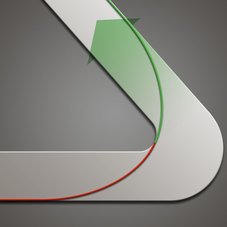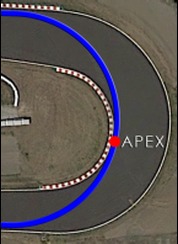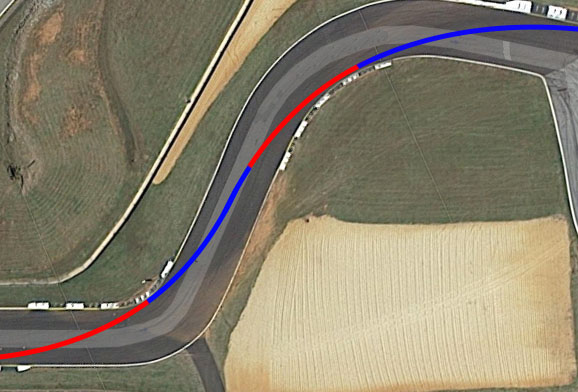
30 Minutes to Grid
Therefore, we wanted to put this article together for beginning drivers to give them something simple to focus on as they learn to drive at the limit. This will be from the perspective of how we would go about teaching a driver at one of their first events. If someone is about to go out on track in half an hour, we're not going to start bringing up Euler spirals and the hierarchy of car control cues. It would unnecessarily complicate the situation for someone who is probably going to need their full concentration just to stay on track.
We want to make sure you understand however, that this basic racing line is different from an ideal line based on Line Theory and is not what you will eventually want to focus on. For a novice driver however, this article will help get you up to speed quickly by focusing on simple goals, but also goals that will translate well as skills advance. While this is not what you will eventually be doing, these goals are designed to be built upon and you won't have to unlearn anything as you progress. Instead, your skills will be able to simply evolve.
Neither the ideal line based on Line Theory, nor this basic line is merely a path you follow around the track. They each consist of a set of goals that you will follow throughout a corner. A good place to start looking at the goals of the basic line is with a standard corner. A standard corner is one that is separate from any another corner and not part of a multi-turn sequence such as a chicane or double apex. In a standard corner, we suggest the novice should focus on just two goals. Maximizing speed at the apex and applying a good amount of throttle as they pass that apex. You shouldn't focus on trying to follow a certain "line" or hitting certain points. Instead, we want you to try to drive more instinctively. We basically want you to simply try and drive as fast as possible while following these two goals.
But what about braking points, turn in points, etc? Many drivers will often ask about things like the ideal braking points and the best line to follow, but if you aren't consistently driving at the limit, the exact points you hit don't really matter much yet. The ideal line around a track is only so because you are limited by the vehicle. If you aren't at the limits of the vehicle then the ideal line would actually be the shortest path around the track possible. Therefore, your goal at this stage is to get to the limit at least in some part of the corner. This doesn't have to be keeping the car perfectly balanced at the limit of all four tires throughout the entire corner, but once you at least start reaching the limit, you will have something on which to build.
| Goal #1 - Maximize Apex Speed The first goal of the basic racing line is to put a lot of focus on maximizing your speed at the apex. Or more accurately, increasing the minimum speed you attain in the corner. Right now, you shouldn't worry if you are right at the apex when you hit this minimum speed, although you might begin to notice that increasing your apex speed will require this minimum speed to be at the apex. In the very beginning, don't worry about using the track to its absolute limits. It's not a bad idea to stay away from the curbs and give yourself a margin of error on each side. Your goal at this stage is not trying to set a fast lap, but instead feeling comfortable driving at the limit while improving your ability to sense the speed you enter a corner. There will most likely be too much variation in your performance for your best lap time to tell you much more than that you got lucky on that lap. Probably the most important lap time to pay attention to at this point is your average lap time or trying to improve your slowest lap time. Having one good lap that is a second faster than the rest doesn't matter much if you lose control every five laps costing you significantly more time. |
Concentrating on being able to apply a good amount of throttle as you pass the apex is the other goal of the basic racing line and is a true test of how well your speed sensing abilities are developing. It will also help keep you safe by making you less likely to go into a corner too fast. If you are going too fast into the corner, you won't be able to get on the throttle very well at the apex without running wide at corner exit. Conversely, if you are able to use maximum throttle at the apex and it's easy to stay on track at corner exit, you'll know you should carry more speed to the apex. Your goal with this is actually to be unable to get on the throttle until the apex. Your corner entry speed should allow you to get hard on the throttle at the apex, but just barely stay on track at corner exit. If you are able to use significant throttle before the apex and still stay on track, you'll know you should carry more speed into the corner.
| Simplifying Complex Sections While not technically ideal, the basic solution that will give you pretty good results through a complex sequence is to concentrate on maintaining the highest average speed possible through the entire sequence and treating the very last apex as a standard corner apex where you should be able to get hard on the throttle as you pass it. The highest average speed will be achieved with the straightest line possible at the limit, so if in doubt, just try to stay toward the middle of the track in between each apex. |
There is no certain point in this process where you will want to start forgoing these basic goals and move on to optimizing your technique through Line Theory. It will be a steady progression as you slowly piece together how each rule fits in with what you are doing and why it makes you faster. This will give you something to ponder while you are analyzing and thinking about your laps later so you have something new to work on each time you hit the track. If you start with the basic goals from this article however, you will be able to quickly work up a good foundation on which to build.
I hope you enjoyed this article. If you are interested in a complete guide to the physics of racing, we also offer The Science of Speed book series, available through our bookstore or at popular retailers such as Amazon.
by Adam Brouillard





